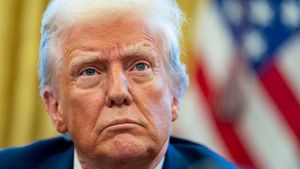On February 3, 2025, the cryptocurrency market plummeted dramatically, following President Donald Trump's announcement of new tariffs on imports from Mexico, Canada, and China. The price of Bitcoin, which had seen considerable previous gains, fell sharply, trading around 94,000 USD, its lowest point in two weeks. The recent volatility has caused major cryptocurrencies such as XRP and Solana to experience significant losses.
XRP was among the hardest hit, crashing over 20% within 24 hours, dropping from previous support levels to around 2.35 USD. This downturn signals broader selling pressure across the market, with traders and analysts closely monitoring XRP’s ability to reclaim its previous highs above 3.15 USD. Overall, the cryptocurrency market's valuation dropped significantly, reflecting deepening investor fears.
According to reports, over 1.19 billion USD was liquidated across the crypto sector within the past day alone, with Ethereum leading these liquidations. Just hours after the tariff announcements, Ethereum experienced over 111 million USD worth of liquidations, underscoring the pressure investors felt to exit their positions.
The broader cryptocurrency ecosystem, particularly memes like TRUMP, saw declines too. The TRUMP memecoin showed signs of strain, falling over 30% since the recent launch buzz wore off. Analysts noted its price hovered around 21 USD, down from its peak and reflective of heightened volatility sparked by macroeconomic uncertainties.
Market participants and analysts linked the sudden downturn to Trump's aggressive trade stance, raising concerns of increased trade friction. Caroline Bowler, CEO of BTC Markets, aptly noted, "The trade war initiated by Trump is impacting the entire market. Concerns about trade conflicts and stagflation could lead to economic recession are reflected on the prices of altcoins and Bitcoin." This sentiment has taken hold among crypto investors, many of whom fled to safer asset classes amid the rising uncertainty.
Previously, many cryptocurrency assets had been buoyed by the hope of favorable economic conditions under Trump’s administration. The belief was bolstered by predictions of institutional investments and regulatory clarity. Now, those expectations are hemorrhaging as geopolitical tensions reemerge.
The cryptocurrency market, after being on the upward trend for many months, is now submerged under this economic wave. Bitcoin dropped by more than 14% compared to its historical highs set on January 20, illustrating the swift reversal of fortune. Key players from various cryptocurrencies suffered heavy losses as the total market cap shrank to 3.21 trillion USD, reflecting the panic mode traders thrived under.
Recent price fluctuations, along with consistent declines across the altcoin sector, point to the effects of speculative trading phenomena. Data exhibited dismal reports, with many altcoins like Dogecoin and Solana recognized for their dramatic plummets as investor confidence waned. For Solana alone, the price dipped to around 198 USD, continuing the trend of the market's instability.
Market indicators also provide insight. The recent trends reflect low interest from buyers. With Bitcoin dominant at 59.89%, the panic selling not only impacts its price but has cascading effects on other cryptocurrencies closely following its movements. Analysts have pointed out the correlation as Bitcoin’s price influences the trading behavior of altcoin investors.
Given the recent aggressive trade policies initiated by Trump, fear has swept across the crypto scene. This development can be seen as part of larger economic signals showing underlying weaknesses. Investor unease about the sustainability of growth amid tightening monetary policies often see market shifts, as witnessed during this recent crash.
Looking forward, the market’s fate remains uncertain. Investors are now weighing risks against potential rebounds following the sell-off. The overall sentiment ranges from cautious optimism for recovery to anxiety about potential recession as trading patterns fluctuate dramatically.
While some anticipate renewed investor interest may develop when market conditions stabilize, for now, the signs point to observed volatility as the primary feature of the cryptocurrency narrative. The upcoming period could provide key insights as the crypto market grapples with both its ingrained volatility and the overarching effects from Trump's policies.



